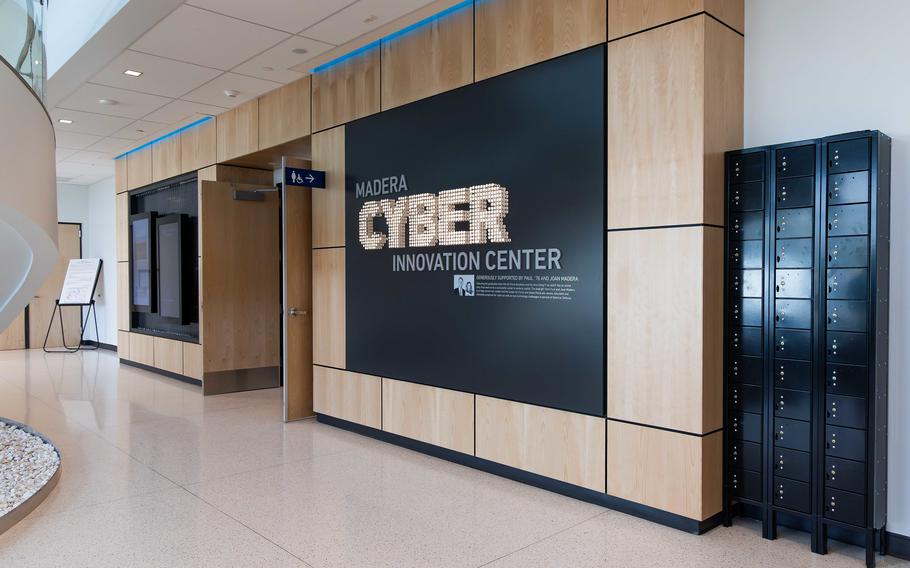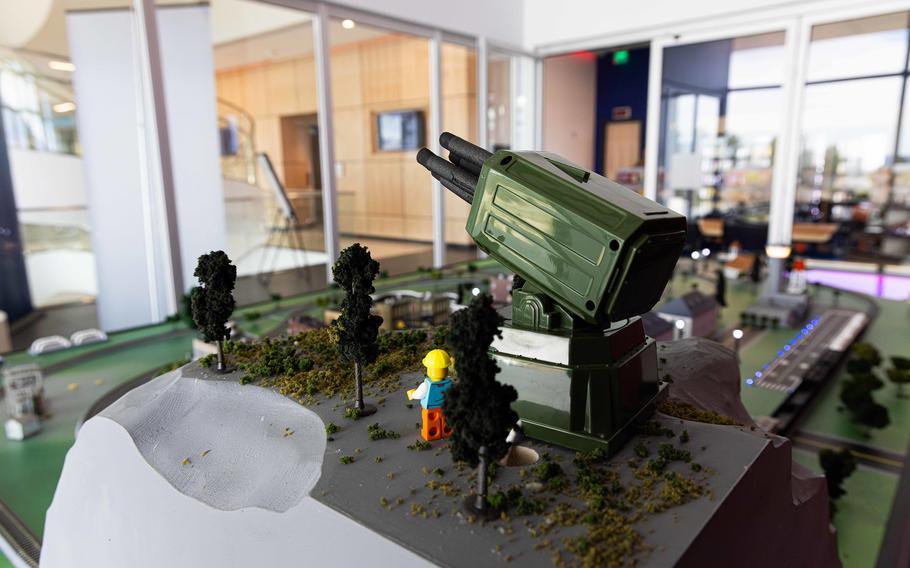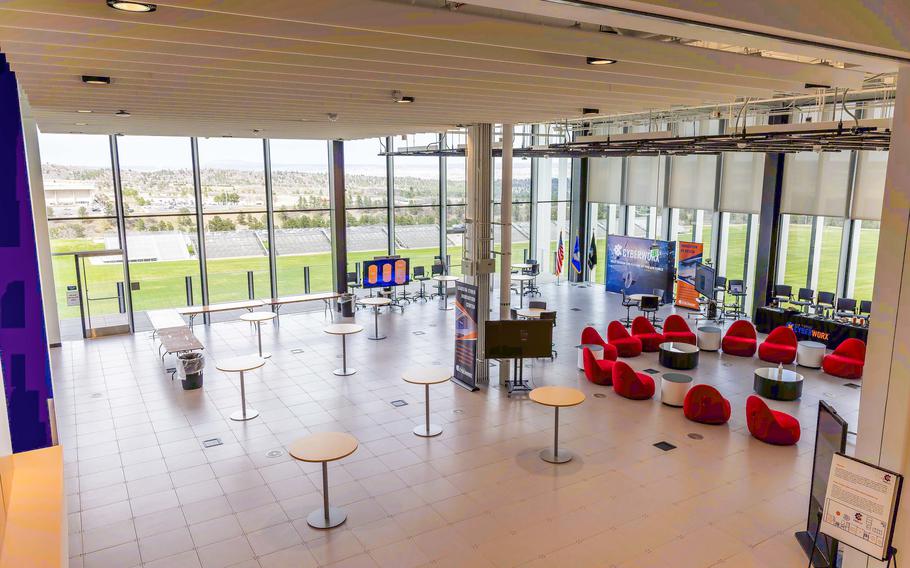
An entrance to the newly opened Madera Cyber Innovation Center at the U.S. Air Force Academy, April 24, 2025. (Trevor Cokley/U.S. Air Force)
COLORADO SPRINGS, Colo. (Tribune News Service) — Air Force Academy alumni and other visitors crowded around a model city, a robotic dog and other cutting-edge technology Friday in the new Madera Cyber Innovation Center on campus.
The open house and celebration marked the end of a 10-year journey and the completion of the largest philanthropic project at the Air Force Academy in terms of total contributions, said Mark Hille, the president and CEO of the Air Force Academy Association of Graduates and Foundation. The brand new 48,000-square-foot building garnered $38 million from 1,199 donors, he said. Those donations matched $30 million in military construction funds.
The large investment is meant to help ensure Air Force Academy cadets are prepared to counter the constant cyberthreats our nation is facing, said Paul Madera, an Air Force Academy graduate and venture capitalist.
“Digital connectivity has made our lives easier, but it has made us significantly more vulnerable to bad actors, hostile nations, states and others, and we are nowhere close to solving that security risk,” said Madera, the building’s namesake.
Lt. Col. Richard McConn had the idea for the center 10 years ago and pitched it to now retired Gen. John Hyten, who was leading Space Command at the time. Hyten and McConn agreed back then on a private-public partnership to fund the center.
In the interim, the Naval Academy opened its Cyber Center in 2020. While Navy’s center is bigger at 206,400 square feet, the Air Force Academy’s center will still be tremendous, providing space for CyberWorx, an Air Force innovation group, McConn said.
CyberWorx will share the 14 laboratories and classrooms in the building, along with 1,400 students annually and partners in industry. The building is outside secure cadet area of campus, making it easier for civilians to access. But also includes secure space that will allow cadets to access real-world intelligence data.
Madera explained that it is critical that cadets are ready to work in cyber warfare because it is always evolving and all of our critical infrastructure depends on it, including the nation’s power plants, health care systems and banking infrastructure.
He noted that small teams create new cyberthreats all the time.
“It’s the reason we see these waves of North Koreans stealing currency and cryptocurrency, the ransomware threats that come from Russian gangs trying to shut down hospitals, banks and oil pipelines, and the ever new viruses that are popping up and threatening us all,” he said.
The effects of cyber warfare will play out at the center in a model city, where cyberattacks can stop the model trains or send one into sinkhole, explained Air Force senior David Petzold.

Part of the model city at the newly opened Madera Cyber Innovation Center at the U.S. Air Force Academy, April 24, 2025. (Trevor Cokley/U.S. Air Force)
The cadets are also learning about artificial intelligence, in one instance using an artificial neural networks to give a robotic dog the ability to learn by demonstration instead of being directly programmed, explained Chad Mello, a community science professor with a doctorate. The robotic dog could be used to map an entire building or carry heavy loads over rough terrain, he said.
Mello’s students are also working with hybrid unmanned aircraft systems that also have wheels, so they can fly through windows or downstairs, but also rove around on the ground. Rolling helps save a huge amount of battery power, he explained.
The work and research is quite advanced for an undergraduate school, he said.
While some materials were set up, classes have yet to get started. Mello’s classes will be moving from Fairchild Hall, one of the original buildings on campus and a little outdated for his work, he said.
As students and staff move in, those who fundraised for building over a decade hope to see it provide a foundation for the future, they said.
Superintendent Lt. Gen. Tony Bauernfeind also voiced high hopes for the instructors at academy.
“It is here that they will unleash our cadets to be innovative war fighters, maintaining our competitive advantage over any adversary that wishes to test our nation,” he said.

The new Madera Cyber Innovation Center at the U.S. Air Force Academy, April 24, 2025. (Trevor Cokley/U.S. Air Force)
© 2025 The Gazette.
Visit www.gazette.com.
Distributed by Tribune Content Agency, LLC.